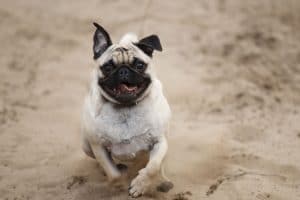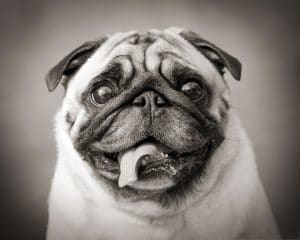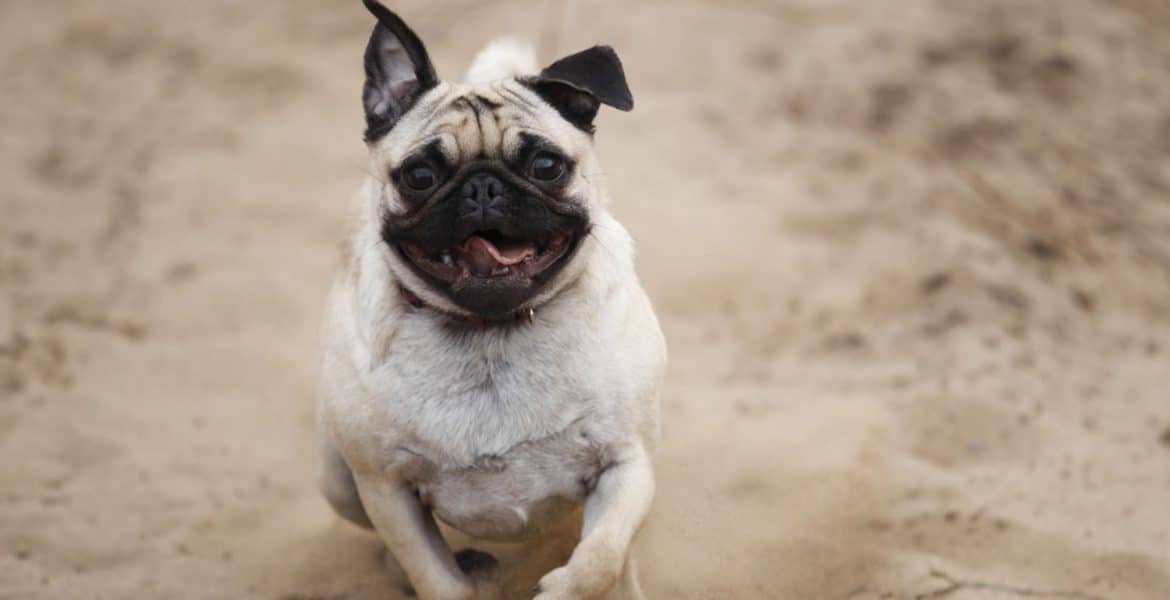 The true origins of the Pug breed are still unclear, as the first Emperor of China destroyed all records relating to the breed during his reign between 221 and 210 B.C. What is known is that this toy breed has enjoyed a pampered life as a pet of many a member of royalty. Pugs have adorned the laps of Chinese monarchs as far back as 400 B.C. and they were also kept as pets in Tibetan monasteries. Pug statues, or back then as they were referred, statues of lion dogs, were placed outside Chinese temples, as they were considered as guardians
The true origins of the Pug breed are still unclear, as the first Emperor of China destroyed all records relating to the breed during his reign between 221 and 210 B.C. What is known is that this toy breed has enjoyed a pampered life as a pet of many a member of royalty. Pugs have adorned the laps of Chinese monarchs as far back as 400 B.C. and they were also kept as pets in Tibetan monasteries. Pug statues, or back then as they were referred, statues of lion dogs, were placed outside Chinese temples, as they were considered as guardians
The popularity of Pug to the rich and powerful is not just exclusive in the Orient. During the 16th and 17th century, the breed reached Europe via trading ships. From then on, Pugs have lived the European royal life. A Pug named Pompey earned the favours of the Prince of Orange in Holland after saving the prince from an attempted assassination.
During the 18th and 19th century, the Pug’s popularity extended to France. Josephine, Napoleon Bonaparte’s wife had a Pug named Fortune. Fortune served as the bearer of secret messages between Josephine and her husband during her imprisonment. In England, the breed soared in popularity after it caught the interest of Queen Victoria. Queen Victoria herself started breeding Pugs and her interest in the breed paved the way for the establishment of the Kennel Club. Lady Brassey, another Aristocrat around that time made black Pug’s fashionable after she imported some from China.
The breed reached American shores in the 19th century and the American Kennel Club recognized it as a breed in 1885.
One of the most distinctive characteristics of a Pug is its short and stocky appearance, often described as cobby. They have a square-shaped body with short legs. Another very distinct feature is the short, flat, wrinkled muzzle. Pug’s have a head which is relatively large in proportion to their body. They are also known for their velvety soft ears and very large, globe-like eyes. Pug’s have two possible shapes for their ears, either being described as ‘rose’ or ‘button’ with ‘button’ ears being preferred in the breed standard.
 The tail is also distinctively curly, with double curls being very desirable. The coat is short but very glossy, fine and silky. Coats can be in the colours of fawn, silver, apricot or black. As for the markings, they have to be as well defined as possible. Pugs ideally weigh between 6.3 to 8.1 kilograms.
The tail is also distinctively curly, with double curls being very desirable. The coat is short but very glossy, fine and silky. Coats can be in the colours of fawn, silver, apricot or black. As for the markings, they have to be as well defined as possible. Pugs ideally weigh between 6.3 to 8.1 kilograms.
One of a Pug’s many wonderful characteristics is their ability to make great watchdogs. A Pug does a great job in announcing the presence of a perceived intruder or stranger. Unlike other toy breeds, Pugs do not bark over petty, little things. Excessive barking should not be a problem in this breed.
Another great quality of a Pug is their friendly and gregarious personality. It is often in a sweet, happy and willing-to-please mood. With this personality, it is not at all difficult to fall in love with a pug. Pugs are sure to put a smile on your face with their mischievousness and their penchant to show-off. They make great companions for children. They are sociable and are not at all shy with other pets and visitors.
As for grooming, Pugs are low maintenance. Their coats need minimal grooming. Pugs, however, tend to shed excessively but this can be addressed by brushing their coat twice a week. When bathing them, it is important that they be thoroughly dried to prevent them from getting cold. It is also very important to clean the wrinkles on their face as they tend to accumulate dirt and are prone to infection. A Pug’s large eyes need regular cleaning to prevent build-up that may cause irritation. As with most breeds, Pugs enjoy their walks very much – they’re playful, energetic, and great fun to be around.
Pugs are indoor dogs. They’re very sensitive to temperatures due to their short muzzles, which compromise their respiratory systems. It could therefore be catastrophic for them to be left outside especially in severe conditions, such as extreme cold or heat. Pugs are prone to various eye injuries, breathing problems and obesity. Lifespan of this breed is around 12 to 15 years.


